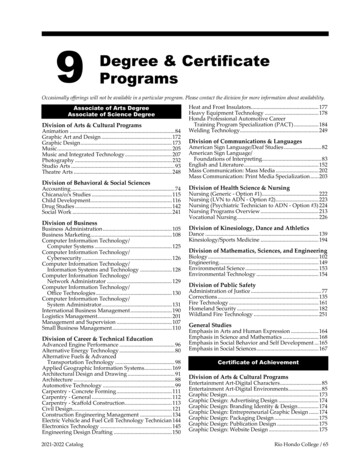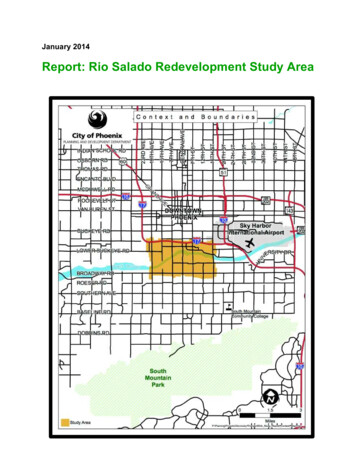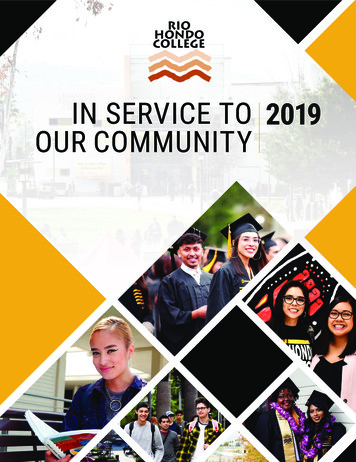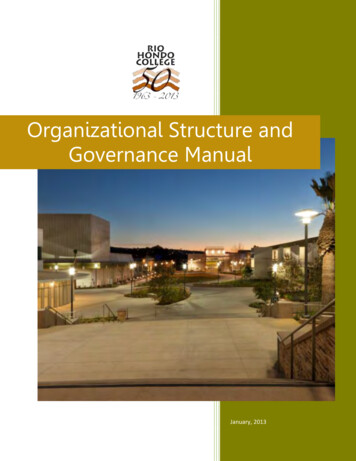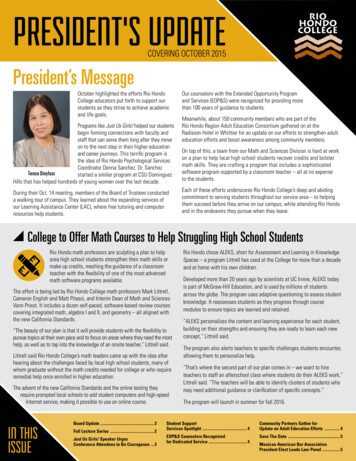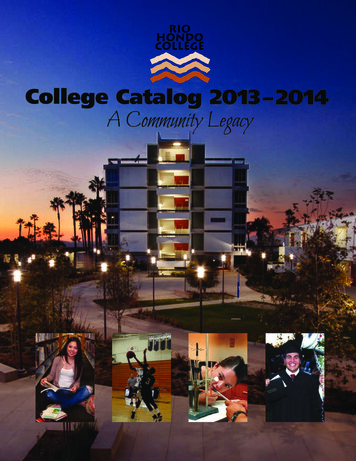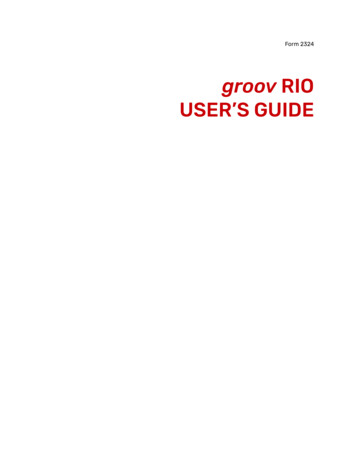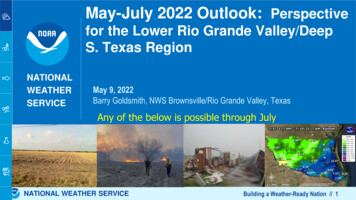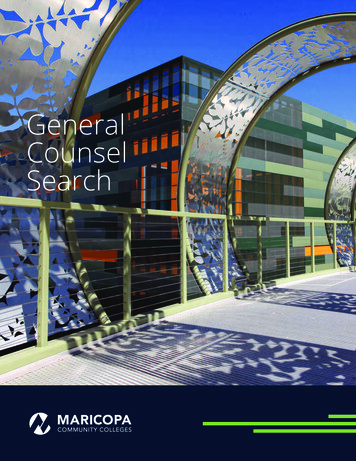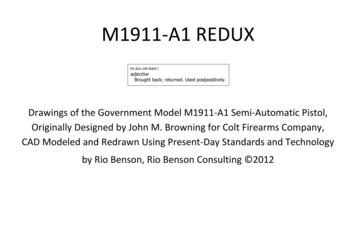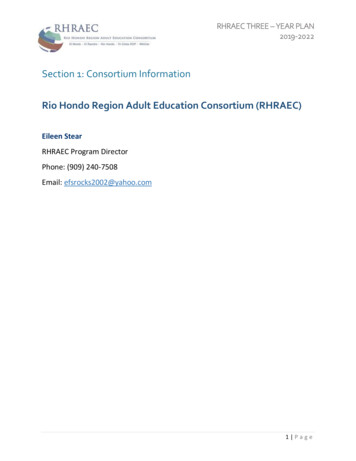
Transcription
RHRAEC THREE – YEAR PLAN2019-2022Section 1: Consortium InformationRio Hondo Region Adult Education Consortium (RHRAEC)Eileen StearRHRAEC Program DirectorPhone: (909) 240-7508Email: efsrocks2002@yahoo.com1 Page
RHRAEC THREE – YEAR PLAN2019-2022Table of ContentsSection 1: Consortium Information . . .1Section 2: Comprehensive Regional Three-Year Plan . . 32.1 Executive Summary . 32.2 Pre-Planning Assessment . 7Table 1. Regional Service Providers . 9Table 2. Funding for Adult Education Programs and Services .102.3 Community Need and Customers . 112.4 Identifying Goals and Strategies . 13Figure 1. Logic Model . 14Table 3. Progress Indicators .182.5 Ploting and Implementation . 19Section 3: Appendix . 222 Page
RHRAEC THREE – YEAR PLAN2019-2022Section 2: Comprehensive Regional Three-Year Plan2.1 Executive SummaryThe Rio Hondo Region Adult Education Consortium (RHRAEC) is very grateful to the StateLegislators, California Department of Education, and the Community College Chancellor’sOffice, for the continued support of adult students.The RHRAEC, is comprised of the following agencies: El Monte Rosemead Adult School(EMRAS), El Rancho Adult School (ERAS), Rio Hondo Community College (RHCC), TriCities ROP (TCROP), and Whittier Adult School (WAS). The consortium currently servesapproximately 20,000 multicultural and diverse adult students. Over the last 4 years, theconsortium has been successful in enabling adult students to achieve their career and educationalgoals.The consortium’s work has been focused on meeting the needs of adult learners throughmonitoring current data for regional economic workforce trends, leveraging resources andcollaborating across district boundaries. RHRAEC identifies student needs, provides interagency referrals and facilitates seamless transitions, thereby benefiting a broader spectrum ofstudents. As an example, all agencies have adjusted course offerings to meet adult student needs.Over the past year, a public monthly meeting has been held to evaluate the previous plan anddevelop future goals and objectives for the 2019-2022 Three Year Plan. Quarterly, consortiummeetings will include an accountability item to review and discuss data collection/submission ofindividual members’ expenditures and outcomes. Member agencies have streamlined/leveragedresources in order to maximize student outcomes. The following objectives were identified andwill be assessed for effectiveness and revised via Annual Plans.Gaps in ServicesESL continues to be a major need in serving adult students within the region. EMRAS, ERAS,and WAS have made modifications in scheduling of program offerings, locations and overallaccess have been provided within the limitations of funding, qualified teachers, and facilities tobetter serve adult students. EMRAS helps eliminate attendance gaps by providing babysittingservices.EMRAS continues to restructure their CTE programs, creating Career Pathways in the trades.Electrical State Certification Program and a construction course have been established for themuch needed trades industry. EMRAS has expanded Pharmacy Tech Program NationalCertification. EMRAS will purchase Robotics Module to begin employer requested course.Based on current census data, ERAS has doubled the instructional minutes per week for GEDPreparation and ABE classes in order to help increase the community’s high school graduation3 Page
RHRAEC THREE – YEAR PLAN2019-2022rate. ERAS has also reinstated a Citizenship Program. WAS has begun a Bus Driver Trainingcourse meeting industry needs in the community. As a result of CPR requirements for thetraining, TCROP will begin offering CPR certification to member agencies, and will also offerContinuing Education Credits for their CNA adult students. RHCC is dedicated to provide acollege counselor to member agencies.Member agencies host advisory meetings to review community and industry needs. Outreach toemployers will be a member agency priority. As well as, collaboration with Workforce agenciesto identify employment trends.All member agencies have worked with RHCC articulating courses. RHCC has successfullyarticulated their accounting course with EMRAS and WAS. RHCC will coordinate articulationmeetings with adult schools. ERAS has created a student-friendly referral form for interagencyadult student transition and to assist in capturing interagency data.The RHCC counselor will hold workshops on successful college transitions and retention. TheRHCC counselor will provide member agencies an availability schedule with dates and time persemester. A counseling log will be provided monthly for review, discussion, and capturing data.Seamless TransitionsMember agencies are dedicated to increasing student completion rates. RHCC, as stated above,will provide a college counselor to the member agencies. RHCC will continue providingCounseling 101 and Spanish 101 at EMRAS and will expand to WAS and ERAS. WAS willimplement ESL to CTE courses “243”. ERAS realigned ESL course levels to better serve adultstudents. RHCC will create Guided Pathways to higher education. TCROP will articulate courseswith RHCC. RHCC will explore hiring an additional counselor.Student AccelerationAll member agencies monitor data for student acceleration and increased completion rates.EMRAS is creating a CTE Cohort Model to reduce time in class. ERAS has doubled theinstructional minutes per week for GED Preparation and ABE classes in order to accelerate GEDCertification. TCROP changed the dental program from two semesters to one. WAS now hasHiSet testing on site. WAS has hired a Student Advocate for high school diploma adult students.RHCC is developing CTE short term courses.Professional DevelopmentConsortium-wide professional development have been held for all “alike” departments ofmember agencies. These professional developments will be hosted annually for the next threeyears. EMRAS will continue to hold monthly data meetings. Staff will be encouraged to attendCAEP workshops and webinars. All member agencies will continue to host department meetings.4 Page
RHRAEC THREE – YEAR PLAN2019-2022Leveraging ResourcesRHCC offers courses at EMRAS. TCROP, ERAS, and WAS work with SASSFA for adultstudent support. Member agencies advisory meetings assist in student services as well asemployment. ERAS hosts TCROP, and Catholic Charities. EMRAS is working with AJCC forcloser location to serve students. EMRAS provides Regional Data and ASAP Meetings. RHCCcollaborates with EMRAS to improve educational access for ESL adult students.RecapRHRAEC has had extraordinary advances for adult students over the past 4 years. EMRAS hassuccessfully provided babysitting services to adult students that otherwise couldn’t obtain aneducation. EMRAS has generated career pathways in their Career and Technical Education(CTE) programs by expanding course offerings, hiring additional instructors, and maintainingstrong enrollment in 6 of the 7 program areas. Over the past 4 years, ERAS increased the numberof adult students served from 100 students to over 600 adult students. ERAS also hired apermanent Counselor who dramatically improved student intake and data integrity with anemphasis on referrals to other member agencies. RHCC has successfully articulated a CTEAccounting course with EMRAS and WAS. RHCC continues to work with the other agencymembers to provide seamless transitions and reduce gaps in services with itsconsortium members. RHCC has provided counseling services to the other 4 member agencies.As of 2018-2019, a total of 96 adult students have completed college applications andsuccessfully transferred into higher education. TCROP has continued to review and refine theirCTE program. Through community surveys and workforce needs, TCROP received an approvalfrom the California Department of Health for their CNA program. Unfortunately, the programwas held for only one semester and was unable to fill the class due to other agencies in the areaoffering the same course. TCROP dental program has shown amazing success over the past 4years with an average of 88 percent completion and job placement. WAS had surveyed the needsof their community, and as a result realigned course offers to meet the needs. WAS hasimplemented a short-term school bus driver training program.A consortium calendar and website has also been generated for all member agencies and theircommunities to provide vital information such as meeting dates, fairs, workshops, events, andactivities. The consortium has monthly public meetings where all stakeholders are invited.Consortium-wide activities are numerous and have been well received and attended. The firstevent was an all-day celebration to roll out AB86, the new model of California Adult EducationPrograms (CAEP). This conference was held at the Whittier Radisson Hotel, and wascoordinated by RHRAEC. Surrounding consortiums where invited to share in the disseminationof AB86. An underlying current of AB86 was to break down the boundaries within regional andneighboring adult education communities. The conference was a successful collaboration thatproved to be a model for future events.5 Page
RHRAEC THREE – YEAR PLAN2019-2022RHRAEC held a caravan for all staff and stakeholders which toured each member agency. Thesite administrator provided a guided tour and explained their successes in the 7 program areas. Inthe beginning of the 4th year, counselors from each of the member agencies gathered at RHCCfor a workshop sharing best practices related to student intake, data collection, and how eachagency can better serve their adult students. Also in the 4th year, members held a consortiumconference at RHCC titled, “Fast Forward to 2022.” This conference stressed the importance ofdata collection, student outcomes, and what staff and faculty perceived important to achievingthroughout the next 3 years.During the implementation of the previous Three Year Plan and Annual Plan, many changeshave occurred. For example, all agencies have had to adjust to rising operating costs, salaries,benefits, materials, and increased security. Fortunately, the 2 COLAs received have offset aportion of those recurring expenses.The challenges over the past 4 years have been widespread and numerous. However, thechallenges are minimal compared to the successful outcomes the RHRAEC has produced.RHRAEC has collaborated in finding resolutions to benefit all member agencies. One agencywas unable to spend all of its allocations, including data and accountability funds. The agencyreallocated the funds among the remaining 4 member agencies after a unanimous vote. One ofthe greatest challenges has been the delay in receiving funds from the State. Another challenge isthe reporting system the Community College uses, the MIS system. The MIS reports are notcompatible with TOPS Pro and are not accessible by other members, which raises a transparencyissue. In NOVA, RHCC has complete access to consortium reporting, which has caused a needfor the consortium reports to be re-entered. In addition, TCROP does not utilize the samereporting system as the adult schools or the Community Colleges. This creates a challenge inaccessing data. Furthermore, there is a noticeable increase in the amount of time and personnelrequired by each member agency to collect and report data. Each member agency continues toabide by separate governing bodies – CAEP, resident school board policies, State Department ofEducation, etc. Moreover, some member agencies have more than one administrativeassignment.6 Page
RHRAEC THREE – YEAR PLAN2019-20222.2 Pre-Planning AssessmentThe Rio Hondo Region Adult Education Consortium is built on a strong foundation ofcollaboration among agencies to provide high quality educational services to adults in our region.THE RHRAEC Coordinating Council meets monthly with the five member agencies to evaluatethe needs and successes of the work of the consortium. Included in these meetings are more than100 regional agencies who are invited to provide input and collaborate regarding regional needsand economic developments.CapacityThe five agencies in the RHRAEC are providing service to participants over a broad geographicregion. The communities served represent diverse populations faced with rapidly increasinghome costs, declining enrollment in K-12 programs, large immigrant populations, and a strongneed for trained workforce in several areas, Manufacturing, Construction, Health Care andTechnology services. A high need in this region is services for immigrant populations and HighSchool completion in addition to career training. Each of the three adult schools have integratedworkforce readiness components into academic curricula. Although all five agencies areproviding services, there is insufficient funding to expand or increase program offerings, developnew workforce preparation programs etc. One adult school, located in an area with a high needfor services to immigrant populations, has struggled to grow fast enough to meet the demand dueto limited funding. The Community College partner has introduced a non-credit ESL programfor the region but is limited by the commitment of funding from the Community College Generalfund. Our workforce partners have indicated that there are limited numbers of job seekersdespite high numbers of employers in need of workers for their various industries.PartnersIncluded in the regional agencies invited to meetings on a regular basis are the workforcedevelopment agencies, EDD, America’s Job Centers of California, LA County Housing andUrban Development, and a variety of social service agencies and employers who all have aninterest in high quality adult education programs to produce strong and effective employment. Inaddition to the RHRAEC Coordinating Council Meetings all agencies conduct CommunityAdvisory and CTE Advisory committee meetings with church leaders, libraries, mental healthproviders and, governmental officials, local law enforcement, and school district stakeholders.AlignmentAmong the five agencies in RHRAEC, two have secured a WIOA Title II, Workforce Innovationand Opportunity Act grant from the federal government. The WIOA Grant providessupplemental funding to support academic and literacy preparation. This grant requirescollaboration with the Workforce Development Board and America’s Job Center of California.This MOU addresses three common goals: Foster demand-driven skills attainment; Enable7 Page
RHRAEC THREE – YEAR PLAN2019-2022upward mobility for all Californians; Align, coordinate and integrate programs. Three agenciesare part of a Carl Perkins Consortium lead through Tri-Cities ROP. The three agencies provide abroad range of Career Technical Development for adults in the Whittier and El Montecommunities.RHRAEC Members began the Three-year planning process in October 2018 with an activityentitled “Where have we been and where are we going”. This brainstorming activity focused onthe Consortium successes in addressing Gaps in Service, Seamless Transitions, StudentAcceleration, Professional Development and Leveraging of Resources. This planning tool alsoprovided an opportunity for RHRAEC members to envision how each agency would addressthese key areas moving forward into the coming years. This process began the discussion of theneed to measure our success through student enrollments and outcomes, and resulted in an actionplan for the activities for the 2018-2019 year.In November 2018 The RHRAEC Coordinating Council conducted the “Consortium ProgramQuality Self - Assessment” tool. Each agency scored their responses on the quality indicators inthe areas of Capacity, Connection, Entry, Progress, and Completion/Transition. The discussionaround these areas resulted in a broad variance in the understanding of our organizationaleffectiveness. This activity was a particularly helpful practice to realign the perspective of eachof our agencies to improve the delivery of programs to our region, In four of the five QualityIndicators the scoring was in the range or 3-4 (out of 5). In Quality Indicator #5,Completion/Transition, the result indicated the greatest need for improvement. While ouragencies have been effective in transitioning students, we have not been consistent in settingtargets or documenting student achievement.In February 2019, The RHRAEC Coordinating Council used the two previous activities todevelop broad goals for the Three Year Plan. Member representative conducted a “Snow Card”activity identifying the goals for the next three years. Those broad goals are: Align ProgramCurriculum, Increase Completion Rates, Improve/Increase students’ services, ImproveTransitions and Pathways for Students.In March 2019, RHRAEC hosted a consortium conference with staff and stakeholders from allconsortium agencies in participation. Two workshops during this conference focused onplanning and assessment. One workshop provided consortium outcome data to all attendees withdiscussions around what the data goals are for the consortium members and how data reported bythe consortium is our verification of agency performance. The second workshop was abrainstorming session to elicit possible consortium activities to address the Consortium ThreeYear Plan Goals that were developed in the Coordinating Council meeting in February.8 Page
RHRAEC THREE – YEAR PLAN2019-2022Table 1. Regional Service ProvidersProvider NameProvider TypeAddress or location(s) where AEservices are providedABE ASEEl Monte-Rosemead Adult School Education10807 Ramona Blvd,El Monte CA, 91731El Rancho Adult SchoolEducation9515 Haney St.Pico Rivera, CA, 90660Whittier Adult SchoolEducation9401 Painter Ave,Whittier, CA 90605Rio Hondo Community CollegeEducation3600 Workman Mill Rd.Whittier, CA, 90601Tri Cities ROPEducation10800 Benavon St. Unit E,Whittier, CA 90606Rio Hondo AJCCSocial Service Agency10400 Pioneer Blvd,Santa Fe Springs, CA 90670Dept of RehabilitationSocial Service Agency10501 Imperial Hwy #14D,Norwalk, CA 90605East San Gabriel ValleyComprehensive AJCCSocial Service Agency14101 Nelson Ave. East,La Puente, CA 91746EDDWorkforce Services14101 Nelson Avenue East,La Puente, CA 91746San Gabriel Valley EconomicPartnershipWorkforce Partnerships4900 Rivergrade Rd. Suite B130,Irwindale, CA 91706Department of RehabilitationSocial Service Agency9350 Flair Drive,El Monte, CA 91731CalWORKSWorkforce Services3350 Aerojet Ave,El Monte,CA 91731Catholic Charities of LosAngele3:15sCommunity Based1530 James M Wood,Los Angeles, CA 90015Program AreasESL CTE AWD WRIf other, provide a briefdescription of services providedPAACSSupports clients enrolled at adulteducation programsFree citizenship applicationworkshops.9 Page
RHRAEC THREE – YEAR PLAN2019-2022Table 2. Funding of Adult Education Programs and ServicesSource and Type of FundsFunding EstimatesFY2019-2020Funding EstimatesFY2020 - 2021Funding EstimatesFY2021-22State / Federal FundingAEP 14,718,342 0 0 146,501 0 0CCD Apportionment 0 0 0Corrections 0 0 0 1,392,959 0 0 122,288 0 0 13,337,721 0 0 80,000 0 0 371,490 0 0 25,087 0 0 0 0 0 0 0 0 0 0 0Cal WORKsLCFF / District FundsPerkins VWIOA IIState / Federal FundingNCSSSPRegistration FeesContracted ServicesTotal15,992,52610 P a g e
RHRAEC THREE – YEAR PLAN2019-20222.3 Community Need and CustomersThe Regional Need for Adult Education and Workforce ServicesThe Rio Hondo Region Adult Education Consortium (RHRAEC) serves an area with over1,100,000 adults. Throughout the RHRAEC, 38.9% of adults ended their formal education withless than a high school diploma or equivalent; this is 413,000 people (Census Reporter).According to the US Bureau of Labor and Statistics (2018), adults with less than a high schooldiploma or equivalent have an unemployment rate of 5.6% compared to the national average of3.2% and earn, on average, 553 per week. Currently, 3.79% of the adult labor force in ourregion is unemployed and 10% of households are living at or below the federal poverty level.This means more than 14,000 adults in our region cannot find work and over 32,500 householdsare impoverished (Census Reporter).For those adults who do not speak English, they are less likely to have a high school diploma orequivalent and less likely to be employed. Currently in our region, 31,000 non-English speakerswith less than a high school diploma or equivalent are not working (Census Reporter).The workforce needs throughout the RHRAEC are dictated by labor market trends, US Bureauof Labor and Statistics information, and local workforce needs unique to members’ geographicboundaries. Some of the areas of need for workforce training include: manufacturing,construction, educational paraprofessionals, health care workers, and technology services.Shared and Unique CustomersAll members of the RHRAEC serve single parents, low income adults, second language students,the unemployed, people re-entering the workforce, displaced homemakers, and those adults withless than a high school diploma or equivalent. Some students are shared between agencies andwithin the consortium, an effort is made to refer students to one another’s unique programs andto accommodate student needs. Some of the unique populations served by one or moreconsortium member include: CalWORKS, disabled adults, Department of Rehabilitation referredstudents, GAIN, homeless students, and adult re-entry. Rio Hondo College serves more studentswith a high school diploma or equivalent and/or some college education than do other membersof the consortium.The Alignment between Needs and ServicesThe sheer number of adults in the RHRAEC region who are deficient in workplace skills, formaleducation, and English literacy is daunting. All three adult schools are offering the classes theycan within budget constraints to meet the needs of our students. The ROP is limited byrestrictions on funding that can be spent on adults. All agencies are working to align programs tothe workforce needs of our communities. Program expansion is costly and limited funds havekept innovation to a minimum. Additionally, current staff lack credentials to meet industry needsand there is insufficient funding to recruit highly qualified instructors for specific technical11 P a g e
RHRAEC THREE – YEAR PLAN2019-2022employment certifications. The three adult schools all saw decreases to their funding from theirrespective districts during flexibility and CAEP money has not brought funding levels back topre-flexibility levels.12 P a g e
RHRAEC THREE – YEAR PLAN2019-20222.4 Identifying Goals and StrategiesThe Rio Hondo Region Adult Education Consortium (RHRAEC) has strategically developedvarious activities to meet the needs of the students. For the past four years, the RHRAEC hassuccessfully enable adult students to achieve their career and educational goals. To continue theconsortium’s focus of serving adult students in the region, the consortium identified four goals tobe met in the next 3 years. Furthermore, these goals would provide a deeper understanding of theorganizational effectiveness and improvement of program delivery for students.The four goals are:1. Improve completion rates across all agencies2. Alignment of transitions and pathways for students across all agencies3. Improve/Increase student services across all agencies4. Align program curriculum across agenciesIn order to reach these goals, various strategies have been created to serve as a catalyst inaccomplishing successful outcomes in the next 3 years. Some of those strategies included but notlimited to: increase of course offerings, track program or course completion, alignment of CTEprograms, create noncredit short term vocational programs, conduct classroom presentations,implement CTE pathways, hire transition specialist, increase counseling services, provide dualenrollment courses at adult schools, increase career exploration services, provide collegeenrollment workshops and activities, and job alike professional development.It is the intent for these goals and strategies to increase students’ success and provide postsecondary educational opportunities to students enrolled in any of the RHRAEC agencies. Eachgoal and strategy will facilitate immediate, intermediate, and long-term outcomes. Theseoutcomes will provide the necessary data to establish good practices of data-driven results.The consortium agencies will continue with a strong collaboration to reach each one of the goalsand activities for the prosperity of our students.13 P a g e
RHRAEC THREE – YEAR PLAN2019-2022Figure 1. Logic ModelGoal Statement: Improve Completion rates across all agenciesOur overall direction and focus for the program cycle relative to the target populations and problems we seek to addressInputsActivitiesOutputsImmediate (Short-Term)OutcomesIntermediate OutcomesLong-Term Outcomes /ImpactIn order to accomplish our set of activities wewill need the following:In order to address our problem or asset we willaccomplish the following activities:We expect that once accomplished, theseactivities will produce the followingevidence or service delivery:We expect that if accomplished these activitieswill lead to the following changes in the nextyearWe expect that if accomplished theseactivities will lead to the following changes in1-3 yearsWe expect that if accomplished theseactivities will lead to the following changesin 3-5 yearsHSE Completion ratesGrad rateCTE certificatesABE completionESL completionEstablished IET pathwayor CDCPProgram completionBiannual Consortium DatareviewEstablished IET pathwayEnrollment dataHours of AttendanceCompletion Data bydepartmentOffer classesAdvertise classesTrack completion dataFollow-up with studentsExplore:Non-traditional class timesOnline curriculumTE and Launchboard dataCTE revision/alignmentProfessional Development toimprove outcomesEstablish baselinecompletion data for eachagencyExamine gaps –Enroll/persist/completeCompletion Data willdrive future course2% increase in completion offerings to be alignedwith current andBiannual Consortium Data emerging community andreview – driving decisions labor market demandsregarding course offeringsLeverage allocation ofProfessional development funds to provide betterin Job Alike groupsofferingsConsortium PLC RegardingDataAssumptionsExternal FactorsFunding – Without the increase of funding our agencies may not be able to AJCC benchmarksoffer new classes due to current collective bargaining agreements that grant External barriers for studentspay increases.Staffing restrictions based on collective bargaining agreementsStaffing – it is assumed that there is sufficient qualified staff to provide theseservicesAJCC referrals14 P a g e
RHRAEC THREE – YEAR PLAN2019-2022Figure 1. Logic ModelGoal Statement: RHRAEC will align Transitions and Pathways for students across all agenciesOur overall direction and focus for the program cycle relative to the target populations and problems we seek to addressInputsActivitiesOutputsImmediate (Short-Term)OutcomesIntermediate OutcomesLong-Term Outcomes /ImpactIn order to accomplish our set of activitieswe will need the following:In order to address our problem or asset we willaccomplish the following activities:We expect that once accomplished, theseactivities will produce the following evidenceor service delivery:We expect that if accomplished theseactivities will lead to the following changesin the next yearWe expect that if accomplished theseactivities will lead to the following changes in1-3 yearsWe expect that if accomplished theseactivities will lead to the following changes in3-5 yearsFacilitation oftransitionsABE to ASEESL to ASEESL and ABE to CTEAdult School topostsecondaryNon-credit to creditSchool to EmploymentDocumentation oftransition for studentsClassroom presentationsAdminTeachersRHC counselorImplementation of CTEpathwayInvestigate:Hiring transition specialistContinue working w/RHC toplace counselor at ASDevelop a system to collecttransition dataDual enrollment classes Adultschool / collegeIncrease in transitionsacross all departments:ABE to ASEESL to ABEESL to CTEData collection toIncrease in transitionsestablish baseline data for across all departmentsstudent transitions2% increase in successfultransition across allCounseling teams tocategoriesMonitor transition dataIncrease of studentsenrolled in CTE pathwaysIncreased transition toemploymentIncreased transition topostsecondaryIncreased transition fromnon-credit to creditAssumptionsFundingRHC counselor assignmentStaffingWIOADual enrollment for adult studentsHSE, HSD to RHCSeamless transition ofstudents to all RHRAECagenciesExternal FactorsMarket demand for CTE pathwaysRHC schedule of classesROP schedule of classesArticulation barriers15 P a g e
RHRAEC THREE – YEAR PLAN2019-2022Figure 1. Logic ModelGoal Statement: Improve/Increase Student Services Across all AgenciesOur overall direction and focus for the program cycle relative to the target populations and problems we seek to addressInputsActivitiesOutputsIn order to accomplish our set ofactivities we will need the
The RHRAEC, is comprised of the following agencies: El Monte Rosemead Adult School (EMRAS), El Rancho Adult School (ERAS), Rio Hondo Community College (RHCC), Tri-Cities ROP (TCROP), and Whittier Adult School (WAS). The consortium currently serves approximately 20,000 multicultural and diverse adult students. Over the last 4 years, the
